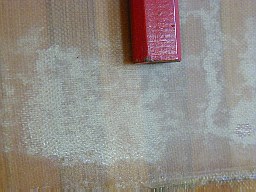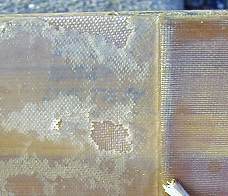| |
Fabric 'whitening'
- It seemed from the 6 month sampling that the whitening of the fibers had
stabilized. It seems now that this condition has worsened somewhat on all
the patches but I would say that the change is the worst on the less viscous
epoxies, namely MAS and Raka as well as WS207. It is clear that the epoxy
shrinkage caused the fibers near the surface (covered by thinner layer of
epoxy than the surrounding) to telegraph through and those fibers were affected
the most.
To me, it is still a puzzling phenomenon and the only explanation I can
think of is that somehow, moisture has penetrated to the fibers through
microscopic fissures opened up by UV degradation and perhaps oxidation being
the aggravating factor. The 'crackling' of the surface is very much similar
in appearance to old oil paintings with chipping paint. The logical progression
may be that the long polymer chains in the epoxy break, the epoxy shrinks
away and the fissures open up more and more until capillary action introduces
some H2O into the fiberglass - and local delamination follows. It is interesting,
however, that the unvarnished patches blocked from light also show some
whitening, indicating that UV is not solely responsible for this type of
damage.
I would also like to mention that I have paid less attention to surface
quality as far as the uniformity and thickness of epoxy coating is concerned
than I would on a kayak hull. In a strictly controlled scientific test,
this shortcoming would be attended to, however, I believe my sloppiness
has inadvertently shed more light on the 'fiber whitening' causes than perfectly
uniform coatings.
One very important fact (and a conclusion) has emerged from this. The fibers
buried the deepest in the epoxy filler coats, show no or less damage and
whitening than fibers covered under thin coating. This seems to be universally
true for almost all the epoxies. In order to eliminate this unsightly phenomenon
on a clear coated fiberglassed surface, the fabric must be buried under
more filler coats of epoxy than it seems to need at the moment. "At
the moment", means when you think you are done glassing and the boat
looks like it is ready for varnish. If you want to keep your wooden boat
looking like a glossy gem for many years, put on two or three more filler
coats of epoxy for insurance. If you see any fiberglass weave on the
surface or fibers sanded through prior to varnishing you are guaranteed
to get a fabric print through at best
and 'fiber whitening' at worst. The insidious nature of this comes to light
only months later and there is no cure, short of sanding everything off.
There is no reason to worry though since this condition can be 'nipped in
the bud' as you epoxy and with minimal weight increase.
Click on the images to get a real close-up view. The effect is hardly noticeable
from the small images.
The picture on the left is a perfect illustration of the damage caused by
thin filler layer over the fiberglass. The image on the right shows a 'blob'
of thicker coating (perfect clarity of coating) surrounded by damaged fibers
due to thin epoxy coat. (Raka)
So how did the epoxies do relative to each other in this respect?
Fabric
Whitening
(no varnish, exposed epoxy) |
     |
System
Three |
lowest
% of white fibers |
    |
East
Sys |
|
   |
Raka
|
|
  |
West207 |
|
 |
West206 |
|
 |
MAS
|
worst |
|
Now, the fabric whitening
of the varnished, exposed patches (one goal of this test) rank as follows:
Fabric
Whitening
(varnished, exposed epoxy) |
     |
Raka |
best
- not a single strand |
     |
MAS |
excellent
too |
    |
System
Three |
imperceptible
but very good |
   |
West207 |
light
but visible - poor wet out* |
 |
West206 |
fabric
weave visible |
 |
East
System |
fabric
weave visible |
|
* My fault when epoxying - the fabric showed from the start so it gets an
unfairly low score here
It is quite clear from
the test that varnish reduces 'whitening' significantly but it doesn't prevent
it in all cases. It is also reasonable to assume that varnish effectiveness
is not only confined to UV blocking but to its moisture and chemical resistance
as well.
Erosion of WS206 at 6 months (left) and at 12 months (right):
West System 206 epoxy (5:1 mix) is very water resistant and generally, the
lower the ratio of hardener to resin in the formula the more water resistant
the epoxy is. Of course, that is true only to the extent that the epoxy
can tolerate long term UV degradation and oxidation - meaning, if the surface
stays intact no water can get through.
I believe the degree of damage on the WS206 epoxy is also partially due
to application of fresh epoxy on previously cured (and blushed!) substrate.
I did attempt to clean the blushing but the washing and sanding was not
sufficient for a durable mechanical bond. So, here is a case in point and
a lesson in (im)proper surface preparation. Take a real care when working
with blushing epoxies.
 |
 |
|
| |
Color (hue) changes
-
Another unexpected surprise was the effect of light on the color change
of the wood. It's beyond a doubt that the light-shielded portion of the
panel stayed generally lighter than the exposed areas but the striking
contrast between the colors actually came from the epoxy itself. Some
epoxies went on as very clear coatings (SYSTEM THREE, RAKA) but darkened
beyond all expectations in relation to others. WEST207, on the other hand,
has a strong yellow-green coloration to start with but it turned out to
show the least amount of discoloration. It seems that the hue change is
entirely due to the particular epoxy chemistry and less to the effect
of light. The epoxy darkened consistently even under the light exclusion
band.
So, my conclusion here is that the changes in the color of the wood are
largely due to epoxy chemistry and that the color of the raw epoxy mixture
has almost no bearing on what your wooden hull will look like later on.
Do not assume that a dark colored epoxy will become darker on the hull
in the long run than a completely clear brand of epoxy (clear, meaning
no hue or coloration). The opposite may indeed be true.
Check out the 'new' panel at the top of the page
and compare the colors of the WS207, MAS and System Three. At the beginning,
they show minimal differences. Notice the change after one year.
Color
Change
varnished and unvarnished, epoxy) |
| |
East
Sys |
least
color change |
| |
West207 |
|
| |
West206
|
|
| |
MAS |
|
| |
Raka |
|
| |
System
Three |
largest
color change |
|
|
| |
Gloss and Oxidation
(microscopic chemical erosion of the surface layer)- These two
go hand in hand. The more a surface is oxidized the less glossy it is.
Resistance to oxidation was one of the objectives of the test and the
table below ranks the epoxy brands by "glossiness".
Glossiness
(no varnish, exposed epoxy) |
     |
West207 |
absolutely
top |
     |
Raka |
very
good |
  |
System
Three |
no
loss of gloss* |
  |
MAS |
|
 |
East
System |
not
much better than WS206 |
 |
West206 |
no
gloss |
|
* System Three had a mate non glossy appearance from the beginning of the
test and there has been no further deterioration - it basically stayed the
same. It is slightly glossier than MAS at this point.
West System unconditionally wins the "no varnish - gloss" test
closely followed by Raka. WS207 shows no oxidation at all. West System claims
their 207 formulation contains UV blockers and it shows. As
a note of interest, when I cleaned the remnants of the duct tape with lacquer
thinner, the varnish stayed completely inert, however, the oxidized epoxy
surfaces dissolved into sticky sludge. It would appear that once that epoxy
degrades to some degree, its chemical resistance to organic solvents (like
lacquer thinner) declines rapidly.
All varnished portions of the panel maintained the same degree of
gloss.
|
| |
Protecting your wooden boat - Despite the good results from the "Clarity
test", I say it is still a good idea to cover your hull with some light
proof material. Make absolutely sure to allow the epoxy and varnish (or
any coating) to cure to perfection before you slap a sheet of suffocating
plastic over it. Give your new coatings at least a month to dry and harden.
Protecting the hull in such a manner that permits some air circulation is
very beneficial. If you have done your epoxy work properly (especially the
wetout and thick filler coats) there is little to worry about.
Temperature changes have little effect but light degradation is a fact of
life with epoxies and UV resistant coating is indispensable. The choices
for clear coat are few; there is varnish, polyurethane, sprayed automotive
clearcoat and the newer two part polyurethanes. The polyurethane builds
up faster, has a superb gloss and abrasion resistance but at this point
you might as well adorn your boat with gold leaf - it's that expensive!
($50-60 per 1.33quart). It gets worse still, once you mix up your two part
batch, you either use it or lose it - there is no pouring it back into the
can like paint or varnish. So, is it all worth it? Check out the gloss and
some of my findings with the two part polyurethane.
And the test goes on! Now,
that the degradation of the epoxy has set in, it will accelerate and the
differences between the brands will only accentuate. More stuff to follow...keep
tuned :)
|

